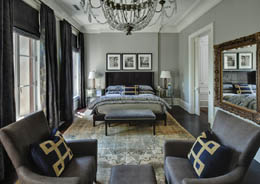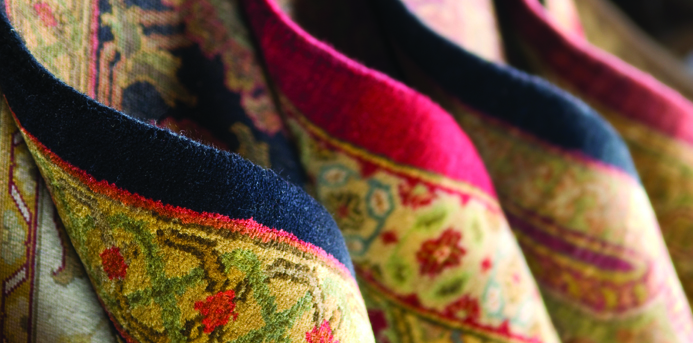The rug is the foundation of your room. It’s a stage for your furniture, warmth for your feet, a soft spot to sit.
But too many tired rooms are anchored by predictable patterns, awkward sizing and poor quality. It’s time to choose the right rug for your space.
Where do you start?
First ask yourself, are you looking for a rug to drive your design or do you simply need a rug to complement what you already have. As Elizabeth Drake of Drake Interiors reminds us, while the rug may be the largest element in any room, it’s up to you to decide if it’s going to be a focal point.
 “There are so many options to choose from,” says Oscar Tatosian of Oscar Isberian Rugs. “I always tell clients, start with a concept that you love—not necessarily a region or country—as that will determine where to look.”
“There are so many options to choose from,” says Oscar Tatosian of Oscar Isberian Rugs. “I always tell clients, start with a concept that you love—not necessarily a region or country—as that will determine where to look.”
In one bedroom, Drake chose a solid rug with a large-scale floral pattern, which inspired the pattern stenciled on the walls and the soft, muted colors and fabrics in the space. For a room with strong color and pattern—or large furnishings in a small space—Drake leans towards a more neutral rug that doesn’t visually compete.
Designer Stephanie Wohlner rarely starts with the rug. “Frankly it’s too hard to drag around.” She defines the other elements in the room (furniture, fabrics, art) and then picks the rug. “There are many options available to my clients today, so rather than let one rug style or pattern drive the decisions, we wait to find the perfect compliment to the entire scheme.”
One of Wohlner’s favorites is sisal, particularly in living rooms that tend to become too formal and unapproachable. “The texture and movement of sisal is warmer and less stiff than a more traditional oriental.”
Both designers veer away from the all-too stoic formula: brown wood and a formal Oriental. Easy ways to amp it up? Graphic yet traditional patterns like a Greek key border or zebra print will add a modern punch.
 Scale is important
Scale is important
Nothing can depress the style of your space faster than a poorly scaled rug. Some designers swear by the “half on, half off” rule that calls for a rug large enough to hold the front half of your seating arrangements with an ample border of flooring. Whatever you do, don’t choose a rug that’s too small and looks like a postage stamp in your room, or go so large that you cover the entire floor. If you want the entire room covered, just choose wall-to-wall and be done with it.
If you can’t afford a rug large enough to adequately fill your space, don’t fret.
Designers will often float a smaller rug on a larger, more neutral (and often less expensive) rug that provides the necessary scale. Drake often opts for the “little jewel” approach and floats a treasured antique rug or unique pattern inside the main seating area, topping it with a glass or acrylic coffee table so it’s easy to see.
 Quality still matters
Quality still matters
All three of our experts agree that clients should invest in a quality rug. But what defines quality and, hence, the higher price?
Cost is measured by the materials used like silk, fine wools and cashmere, explains Tatosian. Construction also plays into cost. Rugs with higher quality stitches and a more knots will result in superior pattern clarity. “These days, people seem more concerned with style than knotting and are more willing to look at quality machine-made rugs.”
Wohlner encourages her clients to wait for the best they can afford, rather than filling a trend with a cheaper version as it only brings down the overall aesthetic value of the whole space.
Along with price, you should consider durability and practicality. Says Wohlner, “Light colored rugs and kids and dogs are not a good match. Think about how you use your room and what kind of traffic it gets. If it’s a room where there will be food or high use (like a family or breakfast room), I would shy away from delicate woven rugs or lots of silk.” Wool is always a good choice as it’s durable and easy to clean up.
 Buying your rug
Buying your rug
If you want a neutral background rug, start with your local carpet store. Most offer a nice selection of sisal and wools, and will bind a carpet into your desired size.
To find a specialty rug dealer, start by asking a designer or your friends for references. Tatosian says choose a retailer that’s been around for a long time and avoid the rug fire sales. “Any good rug salesman should give you plenty of time to look and be ready to answer any question with integrity and knowledge of his products.” You should also be able to take the rug home on loan and try it out in your room. Some dealers, like Isberian and H.C. Nahigian, will accept trade-ins, knowing that a good carpet always has value.
Tatosian adds that just because a rug dealer doesn’t advertise doesn’t mean you can’t find a good value. “I encourage clients to be upfront about their budget, which allows us to show them what we have in stock. Often a dealer may have some inventory on which he’s willing to offer better pricing.”

